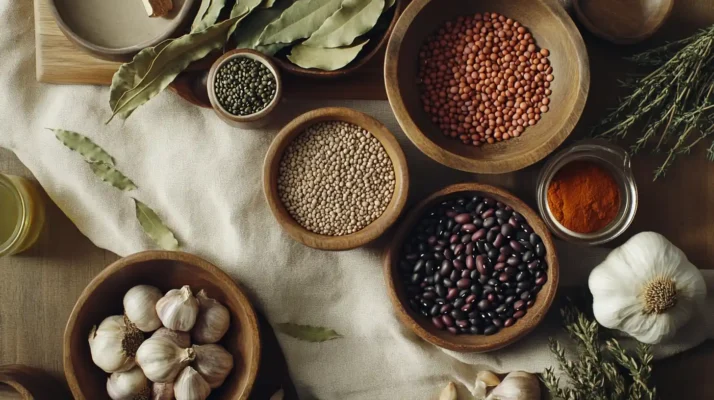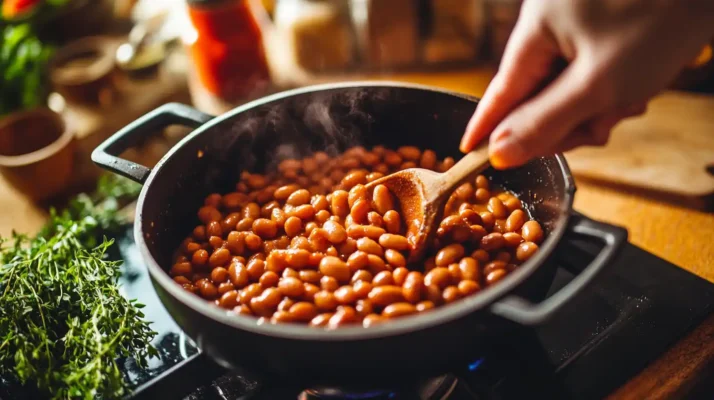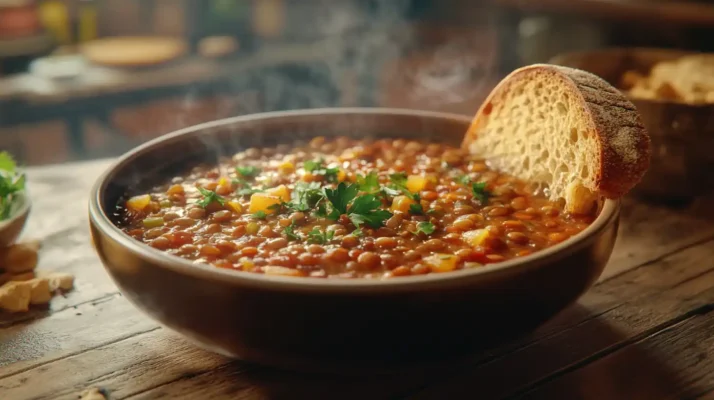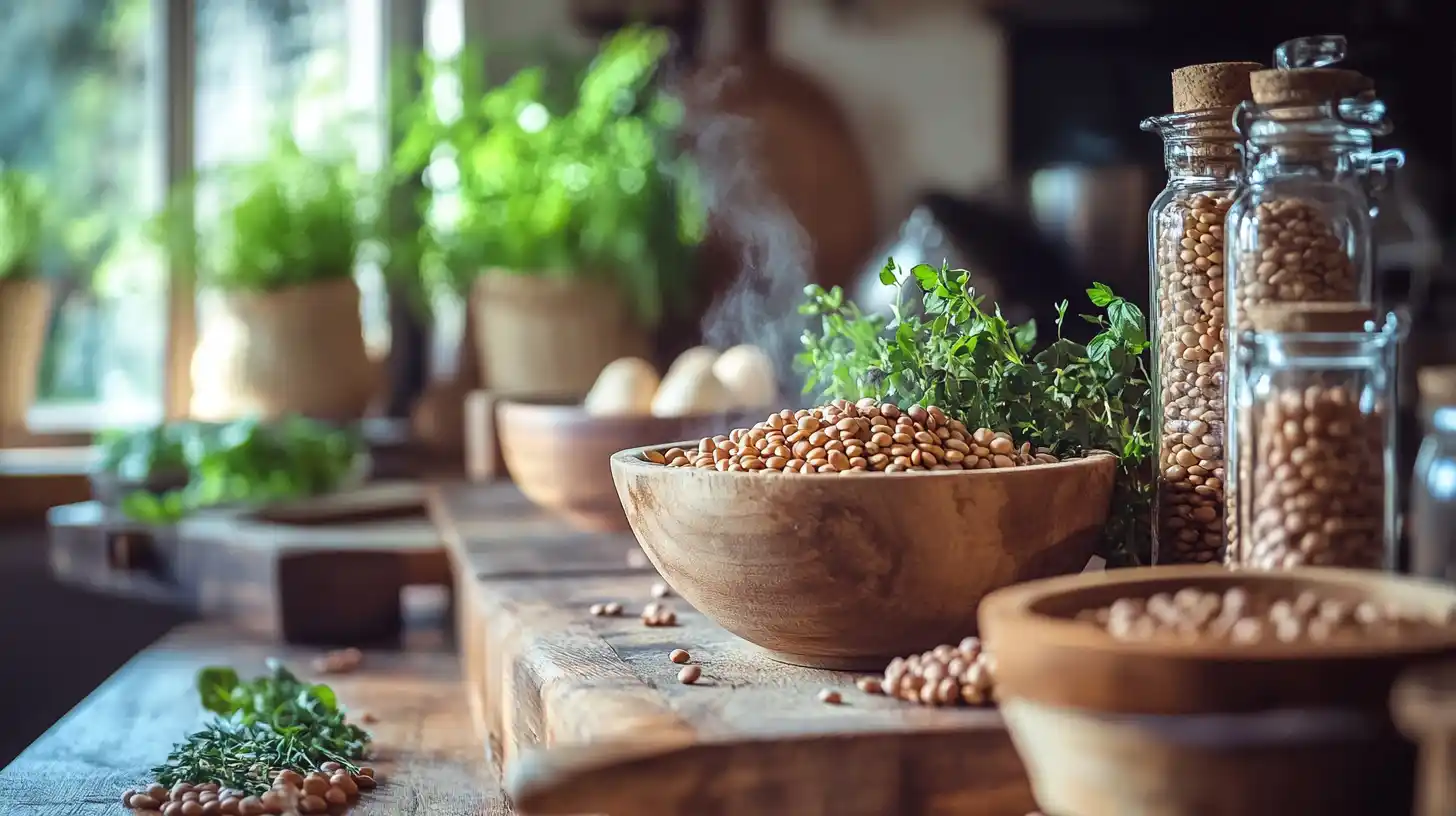This guide explores the world of Legume Recipes, showing you how to cook delicious and healthy meals using beans, lentils, and peas. We’ll cover different types of legumes, cooking methods, flavour combinations, and helpful tips for beginners and experienced cooks.
Table of Contents
Understanding Legumes: Types and Nutritional Benefits
What are Legumes?
Legumes are a family of plants. They produce pods containing seeds. We eat these seeds. Beans, lentils, and peas are all legumes.
Types of Legumes
- Beans: Kidney beans, black beans, pinto beans, and more!
- Lentils: Red lentils brown lentils, and green lentils that cook quickly.
- Peas: These come in many forms, including split and snow peas.
Nutritional Powerhouses
Legumes are packed with nutrients. They are a great source of protein, which helps you grow and stay strong. They also have lots of fibre, which is good for digestion. Legumes give you essential vitamins and minerals, too. Eating legumes helps you stay healthy.
Protein in Legumes
Legumes offer a good amount of protein, making them a healthy choice for vegetarians and vegans.
Fiber Benefits
The fibre in legumes helps your body work well. It helps you feel fuller and also aids digestion.
Vitamins and Minerals
Legumes contain various vitamins and minerals that are essential for your health.
Preparing Legumes: Soaking, Cooking, and Storage
Soaking Dried Beans
Soaking dried beans makes them cook faster and easier. Put the beans in a large bowl. Pour enough water over the plants by just a few inches. Allow them to soak in the tub for at minimum 4 hours, or over the course of a night. This step is essential, especially for harder beans like kidney beans.
Cooking Methods
You can cook legumes in several ways. Boiling is simple: Put soaked beans in a pot with fresh water. Boil them until they’re tender. This usually takes 45-60 minutes, depending on the bean type.
Pressure cooking is faster. Soaked beans cook in a pressure cooker for about 20-30 minutes. It saves time and energy.
Slow cooking is perfect for tender legumes. Add soaked beans to your slow cooker with broth or water. On low, cook for 6-8 hours, or high for 3-4 hrs. The result is very tender beans.
Storage
Store cooked legumes in airtight containers in the refrigerator. They usually last for 3-5 days. You can also freeze cooked legumes for more extended storage. Freeze them in single-serving portions for easy Use later. Lentils: Red lentils brown lentils, and green lentils that cook quickly.
Essential Ingredients: Spices, Herbs, and Flavor Enhancers

Spices and Herbs for Legumes
This section helps you add flavour to your legume dishes. Many spices and herbs go well with beans, lentils, and peas. Experiment to find your favourites!
| Ingredients | Quantity | Note |
|---|---|---|
| Cumin | 1 teaspoon | Great with chili and many bean dishes. |
| Garlic Powder | 1 teaspoon | Adds a savory punch. |
| Onion Powder | 1 teaspoon | Pairs well with most legumes. |
| Paprika | 1/2 teaspoon | Adds a smoky flavor, especially to lentil soups. |
| Chili Powder | 1/2 teaspoon to 1 tablespoon (depending on spice preference) | Use to make spicy bean dishes. |
| Oregano | 1 teaspoon | Adds an earthy flavor to many dishes. |
| Bay Leaves | 1-2 leaves | Adds depth of flavor to soups and stews. Remove before serving. |
| Rosemary | 1 teaspoon | Pairs well with hearty bean stews and soups. |
| Thyme | 1 teaspoon | Adds a subtle, earthy flavor. |
Flavor Boosters
Besides spices and herbs, other ingredients boost the taste of legumes. A little vinegar adds a tangy flavour. Beef bacon adds smokiness—a touch of brown sugar balances savoury and spicy flavours. Lemon juice brightens the taste. Experiment with these to see what you enjoy!
Simple Legume Recipes: Quick and Easy Meals
Easy Lentil Soup
This recipe is perfect for beginners. Sauté a diced onion, and 2 carrots into the same pot.. Add one cup of red lentils, four cups of broth, and a teaspoon of cumin. Cook at least 20 minutes, or till lentils are soft.
Three-Bean Salad
Combine one can of kidney, black, and pinto beans in a bowl. Add chopped celery, onion, and a simple vinegar dressing. This salad is quick and refreshing.
Basic Bean and Rice
Rice should be cooked to a cup in accordance with the instructions on the packet. Heat one can of your favourite beans in a pan. Combine the rice and beans. Add a sprinkle of your favourite herbs and spices. Enjoy a simple, hearty meal.
Quick Tips for Simple Legume Meals
Use canned beans to save time. Rinse canned beans before using them. Many pre-made spice blends are available. Experiment with different flavour combinations! Leftovers make great lunches.
Intermediate Legume Recipes: Exploring Diverse Cuisines
Indian Dal Recipe
This recipe uses red lentils—first, sauté onions and garlic. Then, add the lentils, spices (turmeric, cumin, coriander), and water. Simmer until the lentils are soft. Serve with rice.
Mexican Black Bean Soup
This hearty soup starts with sautéed onions, garlic, and peppers. Add black beans, broth, and your favourite Mexican spices (like chilli powder). Simmer until flavours blend. Sprinkle with chopped cilantro as well as lemon squeeze.
Mediterranean Lentil Stew
This stew features brown or green lentils. Sauté carrots, celery, and onions. Add the lentils, vegetable broth, and herbs (like oregano and thyme). Simmer until lentils are tender. The lemon’s juice enhances the flavor. Serve with crusty bread.

Advanced Legume Recipes: Creative and Flavorful Dishes
Vegetarian Chili
This hearty chilli uses kidney beans, pinto beans, and black beans for a protein-packed meal. Sauté onions, garlic, and bell peppers. Add the beans, diced tomatoes, vegetable broth, chilli powder, and cumin. Simmer until flavours combine. Serve with cornbread.
Lentil Loaf
This meatless loaf is a satisfying main course. Cook brown or green lentils until tender. Mash them with breadcrumbs, chopped vegetables (onions, carrots, celery), and herbs (like oregano and thyme). Add an egg (or flax egg for vegans) to bind the mixture. Shape into a loaf and bake until firm.
Falafel
These deep-fried chickpea patties are a Middle Eastern favourite—mash chickpeas with chopped onions, garlic, parsley, and spices (cumin, coriander). Form small balls and fry until golden brown. Serve on pita bread with hummus and vegetables. They can also be baked for a healthier alternative.
Flavor Combinations
Experiment with different spice blends and additions. Beef bacon adds smokiness to chilli. A touch of brown sugar balances the spices in lentil loaf. Lemon juice brightens the flavours of falafel. Don’t be afraid to try new things!
Legumes in Different Dishes: Sides, Salads, and More
Legumes as Side Dishes
Many legumes make great side dishes. Think of a simple side of seasoned green beans or a hearty bowl of lentil stew alongside roasted chicken. For extra flavour, you can add spices like cumin or chilli powder to beans. Roasted chickpeas are a crunchy and flavorful addition to any meal.
Legumes in Salads
Legumes add protein and texture to salads. A three-bean salad with kidney, pinto, and black beans is a classic. Add chopped vegetables like celery and onion and a simple vinegar dressing. Lentils work well in salads, too, especially those with a Mediterranean flair.
Legumes in Other Dishes
Legumes are incredibly versatile. They can be part of soups, stews, and even vegetarian chilli. You can also add them to rice dishes for extra protein. Experiment with different types of legumes and seasonings to create your unique dishes. Mashed beans can even be used as a base for veggie burgers.

Troubleshooting Common Issues
Gassy Beans?
Beans can cause gas. Soaking beans for several hours or overnight helps reduce this. Adding a pinch of baking soda while cooking can also help. If you still have gas, eat smaller amounts of beans at first. Your body will adjust over time.
Mushy Beans?
Overcooked beans become mushy. Don’t overcook them! Follow cooking times carefully. Different beans cook at different rates; check for tenderness regularly. For beans that are more firm, decrease the cooking time a bit.
Unevenly Cooked Beans?
Some beans cook faster than others. Use a mix of smaller and larger beans to prevent this. Soaking beans makes them cook more evenly. Stir the beans often while cooking. If using a pressure cooker, follow the instructions carefully. Also, if you’re wondering whether beans are still safe to eat after a week in the fridge, proper storage and reheating techniques are essential.
Frequently Asked Questions
What are legumes good for?
Legumes are super healthy! They’re packed with protein and fibre to help you grow strong and help your tummy work well. They also contain a lot of vitamins and minerals.
How long do I soak beans?
Soaking dried beans for at least four hours, or even overnight, makes them cook faster and more efficiently. This is especially important for harder beans.
How do I cook legumes?
For most beans, you can boil them on the stovetop, which takes about 45-60 minutes. A pressure cooker is faster, around 20-30 minutes. Or, you can slow-cook them for very tender results.
How long can I store cooked legumes?
Keep cooked legumes in the fridge in an airtight container for 3-5 days.They can be frozen to ensure long-term storage. Freeze them in single servings for easy Use later.
What spices go well with legumes?
Many spices taste great with legumes! Cumin, garlic powder, onion powder, paprika, chilli powder, oregano, bay leaves, rosemary, and thyme are all good choices. Experiment to find your favourites!
conclusion:Enjoy Your Legume Creations!
Making Legumes a Staple
This guide showed you how to use beans, lentils, and peas in many delicious and healthy ways. You learned about different types of legumes, how to prepare them, and how to add flavour. Remember, experimenting is key! Try different spices and herbs to find your favourite combinations.
From Simple to Advanced
We covered simple recipes perfect for beginners and more complex dishes for experienced cooks. No matter your skill level, there’s a legume recipe for you.
Keep Learning and Cooking!
This is just the beginning of your legume journey. There are countless recipes to discover. Keep exploring and have fun creating your own tasty and healthy legume meals! This guide provides a comprehensive overview of legume recipes, empowering you to make delicious and nutritious meals. Experiment with different legumes and flavour combinations to discover your favourites!
